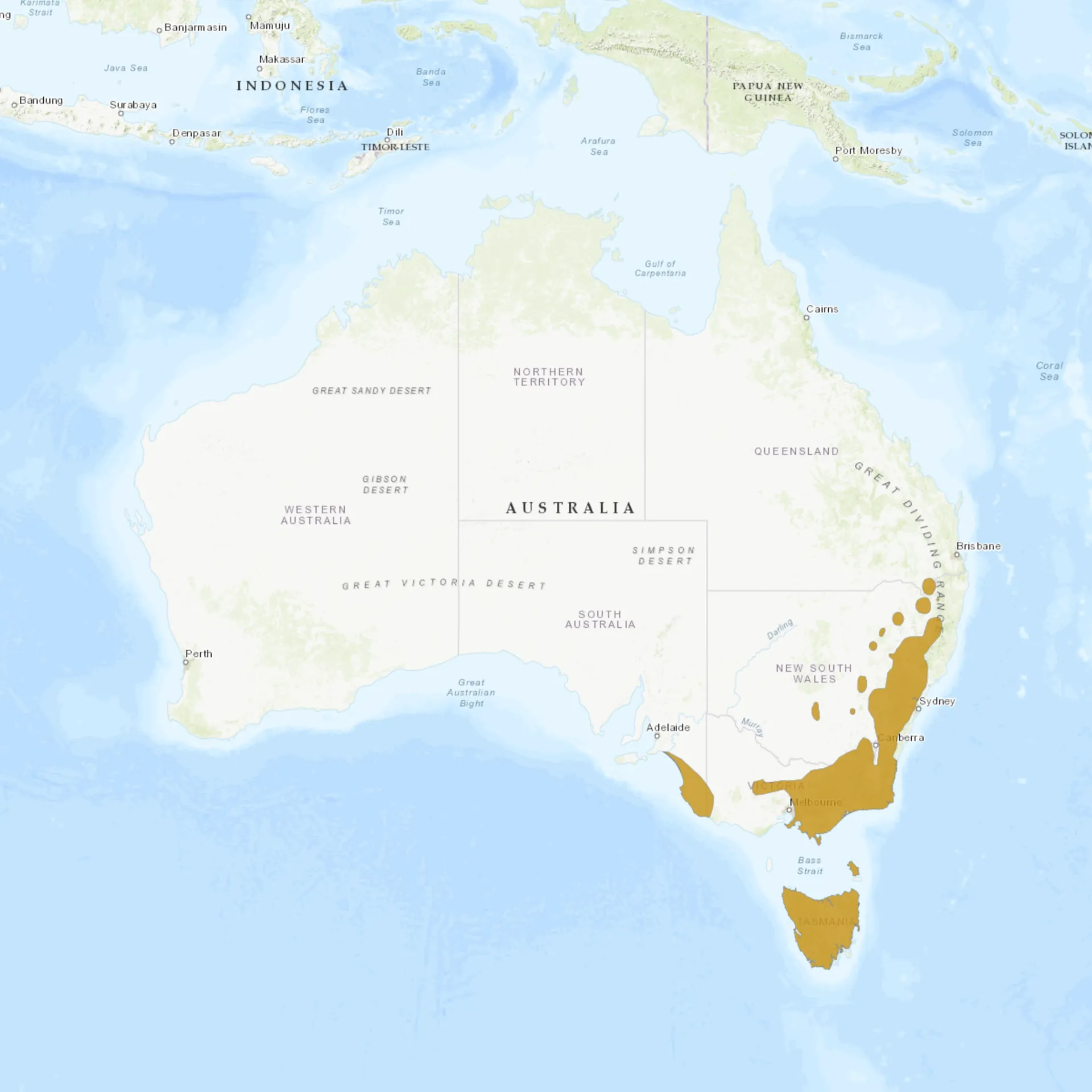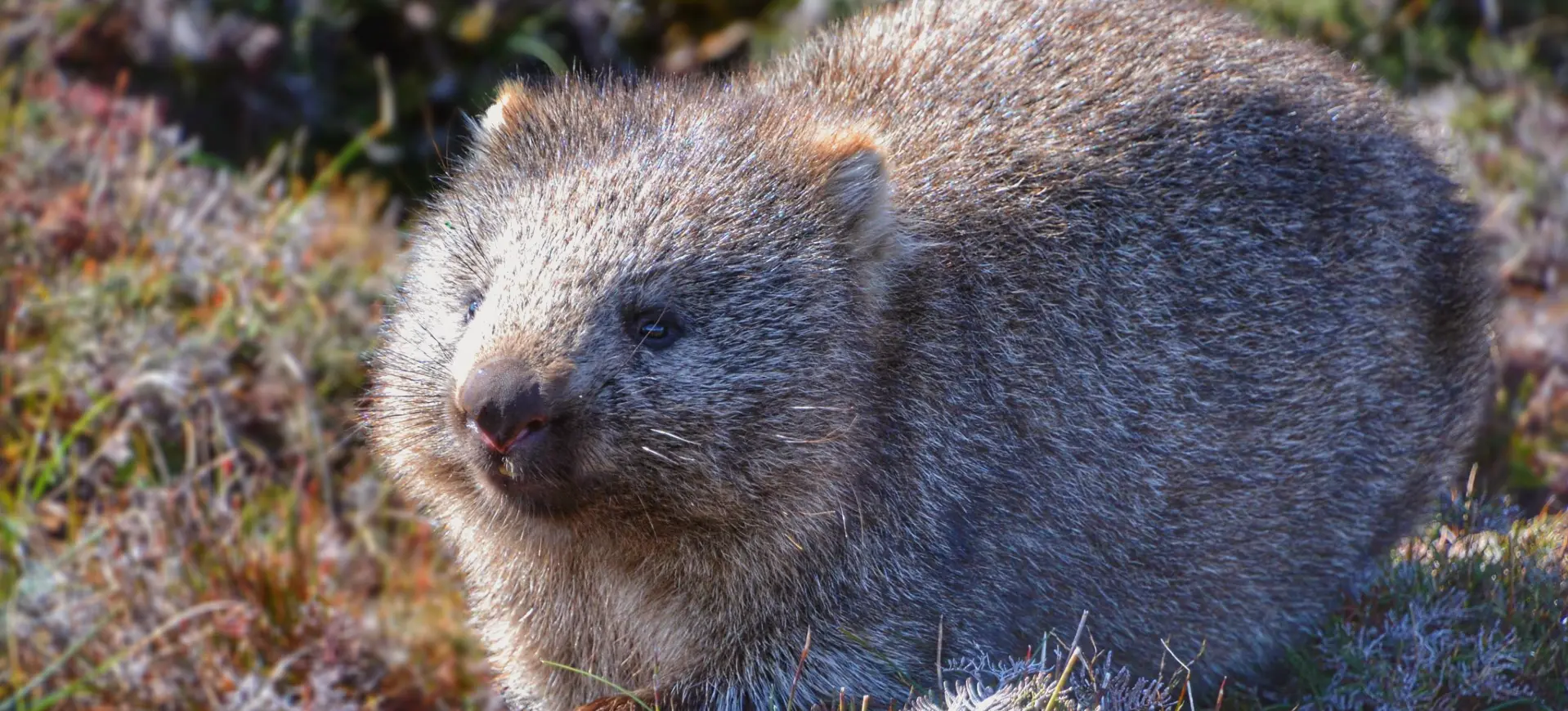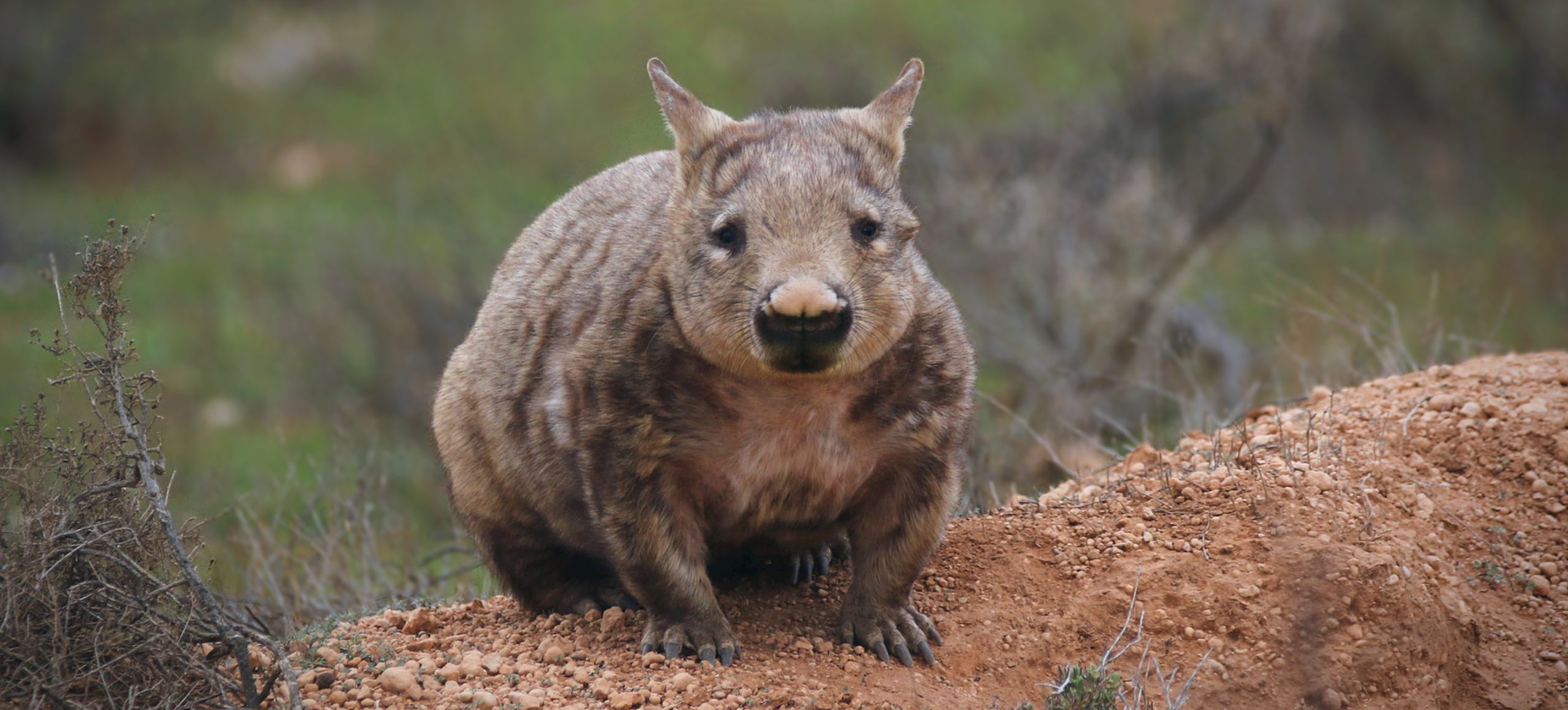Overview
The common wombat (Vombatus ursinus) is a sturdy, burrowing marsupial native to southeastern Australia, including Tasmania. It has a compact, muscular body adapted for digging and is covered in coarse fur that ranges from brown to gray. Unlike other wombat species, the common wombat has a bare nose rather than a hairy one, distinguishing it from its close relatives. This nocturnal animal spends most of the day in extensive burrow systems and emerges to forage for food at night.
Common wombats are well-adapted to various environments, including forests, grasslands, and alpine regions. They possess powerful limbs and strong claws, which allow them to dig complex burrows that provide shelter and protection from predators. Their unique backward-facing pouch prevents dirt from entering while they dig, ensuring the safety of their young, called joeys. With a slow metabolism, they can efficiently extract nutrients from fibrous plant material, helping them survive in regions with low food availability.
These solitary animals maintain defined territories marked by scent glands and droppings to deter intruders. When defending territory, they communicate using vocalizations, scent-marking, and occasional physical interactions. Despite their slow and lumbering appearance, wombats can run up to 25 mph (40 km/h) for short distances when threatened. While not considered endangered, common wombats face habitat loss and road mortality, which impact their populations in some regions.
Taxonomy
Kingdom
Phylum
Class
Order
Family
Genus
Species
Type
Current distribution:
Common wombats are widely distributed across southeastern Australia, from coastal areas to inland regions. Their range extends across Tasmania and the Bass Strait islands, where populations remain stable. In mainland Australia, they are primarily found in forested areas with reliable food sources and burrowing opportunities. While populations are generally secure, localized declines have occurred due to human activity.
Habitat fragmentation and road mortality have affected common wombat numbers in some areas, particularly in regions with expanding agriculture and infrastructure. They are still relatively abundant in protected areas such as national parks and reserves. Some isolated populations face threats from sarcoptic mange, a skin disease caused by parasitic mites that can be fatal if untreated. Despite these challenges, their overall population remains stable, though local conservation efforts are necessary in some regions.
Physical Description:
The common wombat has a robust and stocky body, typically measuring around 3.3 feet (1 meter), with short, powerful limbs. Its fur is thick and coarse, varying in color from sandy brown to dark gray, depending on the region and individual genetics. A large, flattened head with small, rounded ears and a hairless nose gives it a distinctive appearance compared to other wombat species. The rear of the body is reinforced with thick cartilage, protecting predators when retreating into burrows.
Its sharp claws and strong forelimbs specialize in digging, allowing it to construct extensive tunnel systems underground. The wombat’s backward-facing pouch prevents dirt from accumulating while digging, ensuring the safety of its young. Although its eyes are relatively small and suited for nocturnal activity, it has a keen sense of smell and hearing to detect food and predators. Despite its short legs, the common wombat is surprisingly agile and can run quickly when threatened.

Lifespan: Wild: ~15 Years || Captivity: ~20 Years

Weight: Male: 57–88 lbs (26–40 kg) || Female: 55–88 lbs (25–40 kg)

Length: Male: 31–39 in (79–100 cm) || Female: 31–39 in (79–100 cm)

Height: Male: 13–17 in (33–43 cm) || Female: 13–17 in (33–43 cm)

Top Speed: 25 mph (40 km/h)
Characteristic:
Native Habitat:
The common wombat is found in diverse habitats across southeastern Australia, including New South Wales, Victoria, Tasmania, and South Australia. It thrives in environments with ample ground cover and soft soil, which facilitate burrowing and protect it from predators. Preferred habitats include eucalyptus forests, grasslands, and heathlands, where vegetation is abundant. These areas provide both food sources and sufficient shelter in the form of natural rock formations or fallen logs.
Wombats are highly adaptable and can also be found in mountainous and alpine regions, particularly Tasmania. They tend to avoid arid landscapes due to insufficient vegetation and burrowing opportunities. Their burrow systems can extend several meters underground, featuring multiple entrances and tunnels to escape predators. Due to their solitary nature, they rarely share burrows, except for mothers raising their young.
Biomes:
Biogeographical Realms:
Continents:
Countries:
Diet:
Diet & Feeding Habits:
Common wombats are herbivores that eat mainly tough, fibrous vegetation such as grasses, sedges, bark, and roots. Their continuously growing incisors enable them to gnaw on hard plant material without wearing down over time. Their highly efficient digestive system extracts as many nutrients as possible, aided by an extremely slow metabolism that allows them to survive on minimal food intake. They primarily feed at night, using their strong sense of smell to locate suitable plant material.
Water conservation is crucial for wombats, as they obtain most of their hydration from food rather than direct drinking. Their digestive process can take up to 14 days, maximizing nutrient absorption and minimizing waste. Wombats are known for producing cube-shaped feces, which helps prevent the droppings from rolling away and aids in territory marking. Due to their grazing habits, they play an important role in shaping their ecosystem by maintaining vegetation growth.
Mating Behavior:
Mating Description:
Common wombats are solitary animals that only seek mates during the breeding season, which varies depending on environmental conditions. Males may compete for access to females, often engaging in aggressive interactions such as biting and chasing. Courtship involves a brief but intense pursuit, after which mating occurs in burrows for added protection. Unlike many marsupials, common wombats do not form lasting pair bonds, and males do not contribute to offspring care.
After a gestation period of about 20–30 days, the female gives birth to a single, underdeveloped joey that crawls into her pouch for further development. The joey remains in the pouch for about six months, continuing to nurse and grow before venturing outside. Even after leaving the pouch, young wombats stay with their mother for several months, learning essential survival skills. Females typically reproduce once every two years, ensuring they can provide adequate care for their offspring.
Reproduction Season:
Birth Type:
Pregnancy Duration:
Female Name:
Male Name:
Baby Name:
Social Structure Description:
Common Wombats are primarily solitary animals. Each establishes its home range, which may or may not overlap with the ranges of other wombats. While they are generally not social creatures, they do exhibit some level of social tolerance, as they are known to share burrows, particularly during extreme weather conditions or in adverse environmental scenarios. This behavior is considered a survival tactic, allowing them to conserve energy and resources.
Wombats communicate with one another using a combination of vocalizations, such as grunts and screeches, as well as olfactory signals, like scent marking. This helps them establish territories and avoid confrontations. Despite their somewhat solitary and gruff exterior, Common Wombats are known to display playful behavior, particularly when they are young. This playfulness is observed more frequently during their juvenile stages and provides them with the skills they need for survival as adults.
Groups:
Conservation Status:
Population Trend:
The Common Wombat is currently classified as “Least Concern” by the IUCN, thanks to its broad distribution and generally stable population figures. While it’s challenging to pinpoint exact numbers, estimates indicate that several million Common Wombats are living in the wild today. This classification suggests that, at least for the time being, the species is not facing an immediate threat of extinction, allowing for ongoing study and conservation efforts.
Despite this relatively positive outlook, Common Wombats face various threats that could impact their long-term survival. These include habitat destruction from urbanization and agriculture, road mortality due to increased human activity, and susceptibility to diseases like mange. However, their population seems to be maintaining a steady state, and research even indicates that in many regions where they are found, their numbers may be on the rise. This resilience demonstrates the species’ ability to adapt and survive in changing environmental conditions.
Population Threats:
One of the significant threats facing the Common Wolf is the loss of habitat due to the expansion of agriculture and human settlements. This encroachment fragments their natural living spaces, making it increasingly challenging for them to locate suitable regions for digging burrows and foraging for food. The degradation of their habitat stresses the species, as they have to travel farther to find necessities, which exposes them to additional risks.
Additionally, the wombats are frequently threatened by vehicular collisions, especially as they cross roads during their nocturnal foraging activities. This human-wombat interaction poses a significant risk to their well-being and contributes to mortality rates. Diseases, such as mange caused by parasitic mites, also present a serious health threat to the species. These mite infestations are particularly concerning in certain regional populations where the density of wombats is high, exacerbating the spread of the disease.
Conservation Efforts:
Several conservation initiatives aim to safeguard the Common Wombat from various threats. These include habitat restoration projects to regenerate their natural environments, public awareness campaigns that educate drivers about the risks of vehicular collisions in wombat-prone areas, and specialized treatment programs to help wombats affected by mange. These multi-pronged approaches aim to address the diverse challenges that wombats face, offering a more comprehensive strategy for their conservation.
Local governments and wildlife organizations play a crucial role in these conservation efforts by continuously monitoring wombat populations. This involves conducting regular surveys, deploying tagging programs, and using other data collection methods to better understand their habits, range, and overall health. This continual monitoring is essential for assessing the effectiveness of current conservation initiatives and making informed decisions about future programs.
Additional Resources:
Fun Facts
- Wombats are the only known animals to produce cube-shaped feces.
- Their slow metabolism allows them to survive on very limited food and water.
- Wombats have thick-skinned rumps that help block predators from entering burrows.
- Despite their stocky build, they can run faster than most humans over short distances.
- Their incisors never stop growing, similar to rodents.
- They have strong jaw muscles that help them chew tough vegetation.
- Common wombats are excellent diggers and can create extensive underground burrow systems.
- They are mostly nocturnal but may be active on cooler, overcast days.
- Their closest relatives are koalas.
- Wombats have been known to defend their burrows fiercely, even against larger predators.











